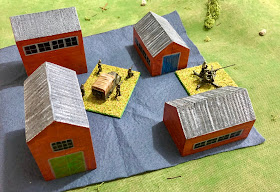Following the morning action fought between Cooper's Confederate division and Cope's division the battle (mini campaign) moves on to midday and orders written. In the case of the Confederates army this means two sets of orders: 1) a likely set of orders and 2) an alternate and less likely orders.
Here are the two sets of Confederate orders:
On a dice roll of 1-4
- Lyon's division to hold position
- Greg's division to move east towards the bridge
- Cooper's division to shift north and cover the road bridge
- Tanner's division to move east and relieve Cooper's division at the railway bridge
On a dice roll of 5-6
- Greg's division to hold position
- Tanner's division to swing north around Cooper's division to the road bridge
- Lyon's division to cross Redmon's River and swing south east
- Cooper's division to hold position at the railway bridge
A 5 was rolled.
 |
| Battle (campaign) movements |
When moving armies a dice is rolled and the highest scoring army moves one of their division first. Then both sides take turns moving alternatively until all division are moved. Divisions must be moved in the order of the orders (e.g. the Confederate army order would be Greg, Tanner, Lyon and Cooper).
With the orders carried out the next action occurs again at the railway bridge between Cooper's division defending and Rawlin's division attacking. The order of battle is:
Cooper's division
- 3 infantry brigades
- 1 artillery battery
- 1 infantry brigade will arrive to support in turn 6 from Tanner's brigade
- 2 commanders
Rawlin's division
- 4 infantry brigades (1 brigade had already be sent to support Cooper's division in the morning)
- 1 artillery battery
- 1 infantry brigade is avail for support from Brown's division in turn 6
- 3 commanders
With the tabletop already setup from the previous game, it did not take long for the units to be deployed. Rawlin's division had a slight numerical advantage and planned to take fight to Cooper's weakened division. They planned to cross simultaneously at the ford and railway bridge.
On to the game which was most enjoyable, so much so that I forgot to take photo's towards the latter part of the game.
 |
| Tabletop deployments and planned attacks |
 |
| Union troops quickly crossed the river |
Union troops moved swiftly and were able to successfully cross Redmond's River. Skirmishing soon occurred supported by artillery fire. Casualties began to mount on both sides, the Confederate brigade positioned in the fields proved to be very troublesome on the flank of advancing Union units.
Reserve units arrived just as casualties began to result in lost units. The Union reserves marched very quickly and were soon in sight of the bridge.
 |
| Reserve units arrive from both sides |
Union reserves arrived at the bridge just as they became the only remaining Union infantry unit. When this occurs the units may only defend and not advance towards enemy units. Remaining Confederate units made a last ditch and unsuccessful attempt to dislodge them.
 |
| A final attempt to dislodge Union infantry defending the bridge |
A slim Union victory which came at the cost of an exhausted Rawlin's division. Cooper's Confederate division was not much better off and limped away westward. These divisions will not be able to recover they losses until night time.
 |
| Division positions as the battle moves into afternoon |
Having written orders for the campaign has got me thinking about having written orders for the game occurring on the tabletop. Taking a similar approach with Confederate forces by writing two sets of orders and dicing to see which set are carried out.



















































